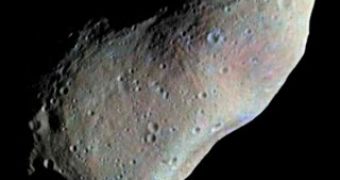Asteroids, like most of the bodies in the solar system, have stable orbits around the Sun, as all of them have their origins in the debris left behind by the planet formation process. They are spread through all over the solar system, but are mostly concentrated in an area of space called the asteroid belt, situated between the planets Mars and Jupiter. They are commonly referred to as minor planets, and while we know many things about them, certain aspects still represent mysteries.
For example, NASA has catalogued a large number of these bodies, in the hope that they would be able to determine whether any of them present any immediate danger for Earth. However, calculations reveal that, out of the whole population of asteroids present in the solar system, we have been able so far to catalogue only about one percent, the rest of them evading detection. Being remnants of the planetary formation process, they consist mostly of basaltic rock, such as that found in the Earth crust, which contains high amount of olivine mineral.
This is also the case of the Vesta asteroid, the second largest body in the asteroid belt, after the minor planet Ceres. With a diameter of more than 500 kilometers, Vesta is responsible for about 9 percent of the entire mass of the asteroid belt. The fact that there are not many large asteroids such as Vesta and Ceres in the asteroid belt, might have something to do with the influence of the two gas giants beyond the asteroid belt, Jupiter and Saturn, which smashed any large object inside the belt with the help of their gravitational pull.
During the collisions of these asteroids, some were ejected from their orbits around the Sun and sent towards the inner regions of the solar system, thus towards Earth as well. Calculations related to the formation of the solar system suggest that the amount of matter now present in the asteroid belt is about 10 percent of the original mass present between the planets Mars and Jupiter, while the other material, scattered through the whole solar system, causes massive collisions with the inner planets.
If you are wondering were are these bodies coming from, you probably already know the answer, as the vast majority originate in the asteroid belt, and eventually get ejected from it during collisions. While most of the past analysis made on asteroids concentrate on studying their chemical compositions to determine their origins, by comparing them to meteorites, most of the time these did not match. Only after NASA launched two of its missions, the Galileo and NEAR Shoemaker, the mystery has been unveiled revealing that the meteorites come from collisions between asteroids; also, that the difference in the chemical makeup varies largely due to the action of solar winds and the transformations which take place during collisions with other meteorites or asteroids.
Another mystery related to asteroids is the origin of the enhanced brightness, observed in the Vesta asteroid. While it is not the biggest minor planet, it certainly is the brightest, approximated at about three times that of the Moon, which cannot be explained yet. Certain theories suggest that this is due to the interaction between the solar winds and the asteroid's magnetic field, which reflects back into space part of the elementary particles raining down on it constantly.
Nevertheless, this mostly remains a speculation, until the spacecraft Dawn completes the survey on the two largest bodies in the asteroid belt.
One might wonder whether or not there is any chance of such an object hitting our planet, and what would be the consequences of such an impact. The fact is that many asteroids hit our planet in the past, and many will hit it in the future, the problem is we don't know when. It could happened now, or tomorrow, however such a possibility has an extremely small probability, as we would detect any threat before it would collide with Earth. Depending of their size, some could produce local damage, like destroying an entire city, for example, or could potentially destroy all life on Earth, and even the planet in the case of a so-called planet destroyer.
Nevertheless, the subject is yet controversial, because if an asteroid would change its trajectory towards Earth, there would be nothing we could do, except view our own end.

 14 DAY TRIAL //
14 DAY TRIAL //